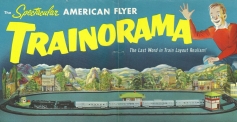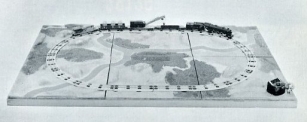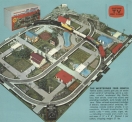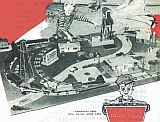Layout in a Box
 Trainorama |
 Scenarama |
 All Aboard |
 3rd Party Products |
Let's face it. As kids, most of us didn't want just a train set running on simple circle or even an oval of track. We wanted a train layout. Something like the 2nd floor Gilbert Hall of Science Layout or one of the big department store layouts would do nicely, even if we had to scale it down to whatever space we could get from mom and dad. To my mind, the 1952 catalog, with its stark illustrations of pitiful circles of track, or in the better sets, ovals of track, displaying the rolling stock was downright depressing and not a real good marketing idea. It brought home with startling clarity what we were actually getting. While that left it up to us to make it into the layout we really wanted, it would have been nice to get the makings of a real layout in one box. Most importantly it would have been quicker and as kids quicker was definitely better. Instant gratification was as popular then as it is now. Sure, we would add our own touches to make it our own, but we would have been a lot closer to the end result we wanted.
Gilbert had no trouble creating dealer display layouts, containing more or less scenery, as shown elsewhere on this website, but they were costly construction projects and not something that could be mass produced. While they were generally not available to consumers, their potential as a consumer product did not go unnoticed by Gilbert, who stressed that they could be sold to model railroad hobbyists after they had served their initial purpose as a sales display.
Starting even with the earliest sets, Gilbert would add accessories to increase the desirability of various sets, but the accessories weren't the answer. After all, we could save up and buy the accessories later ourselves. What was hard for us was the scenery. As a kid, I remember trying to do scenery but ending up with droopy mountains that sloped at unnatural angles and I won't even get started on the mess.
There were also third party products designed to simplify the task of creating a reasonably realistic American Flyer layout. One of these was the Tom Thumb Fold-Away Train town offered by a company in Waterbury, Connecticut.
Many thanks to Lonny Beno, David Dewey, Bill Sheneman, and Daryl Olszeski for their assistance in developing these pages.